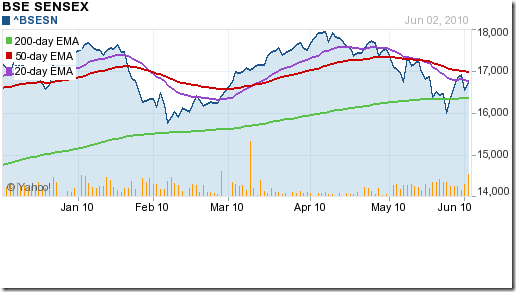Why does it matter if we are in a Bear Market or Bull Market? Aren't we supposed to concentrate on individual stocks - particularly the ones in our existing portfolio? Well, yes and no.
The current market situation is just the kind that is likely to confuse and confound the small investor. One day the Sensex falls 400 points, two days later it rises 300. Some stocks are hitting upper circuits. Others are hitting lower circuits.
Some popular stocks from the previous bull market are down in the dumps. Others that were unknown and forgotten are charging up the charts. Are you supposed to switch from the non-performing stocks to the outperforming ones? Are you supposed to sell and sit on cash?
Where do you invest the cash? In fixed deposits? Post Office MIS? Gold ETF? Liquid Funds? Balanced Funds? So many questions, and so many choices!
We need to get back to the original question. It is important to identify the primary market trend, because that will determine the overall investing strategy. If the primary trend is a bull market, then you are supposed to buy the dips. If it is a bear market, you are supposed to sell on the rises.
That brings us to the definition of a bull or bear market. In technical analysis terms, the 200 day EMA is the trend decider. If the Sensex is above its 200 day EMA, it is a bull market. If the Sensex is below the 200 day EMA, it is a bear market.
What if the Sensex dips below the 200 day EMA - as it did when it fell down to 15960 - and jumps back above it? Or, if it falls back below it again? Guess we need to refine the earlier definitions.
The Sensex needs to be above the 200 day EMA and both should be rising in a bull market. It may take a while to do so if the Sensex is recovering from a long bear market. Likewise, the Sensex needs to be below the 200 day EMA and both should be falling in a bear market.
There is another popular definition. If a market rises 20% from its bottom, it enters a bull market. If it falls 20% from the top, it enters a bear market.
But I prefer the earlier definition - which also gives a clear visual indication of whether the index is rising or falling and if it is above a rising 200 day EMA or below a falling 200 day EMA.
To answer the question, let us take a look at the 6 months closing chart pattern of the Sensex:
Note that the Sensex started falling from Apr 7 '10 after hitting an intra-day high of 18048. It made an intra-day low of 15960 on May 25 '10 but closed at 16022 that day - below the 200 day EMA. In 7 trading sessions since then, the Sensex has recovered exactly 1000 points at its close of 17022 today (Jun 3 '10) - i.e. a 50% Fibonacci retracement of the fall from Apr 7 '10 to May 25 '10.
In the process, it has not only moved above the rising 200 day EMA, but also above the falling 50 day EMA and just above the falling 20 day EMA. That means the primary trend remains a bull market and what we have witnessed so far is a correction in a bull market.
But the Sensex is still below the down trend line connecting the two closing tops at 17970 of Apr 7 '10 and 17745 Apr 26 '10. Plus the 50% retracement could mean the end of the pullback from the bottom of 15960. So, the correction may not be quite over yet. Till the Sensex goes past its previous top of 18048, investors need to be cautious about becoming too optimistic.
Likewise, till the Sensex dips below its recent low of 15960, there is no need to panic. It is more than likely that the Sensex may trade between the two extremes, i.e. between 15500 and 18500, before deciding on its next move.
So, stay invested according to your asset allocation plan. Take some profits where available. Buy if you see compelling value. In other words, follow your planned investment strategy and don't get too worried by the daily fluctuations.

1 comment:
Technically we are still in cyclical bull market...
Suchita Ambardekar.
http://www.suchita.biz
Post a Comment